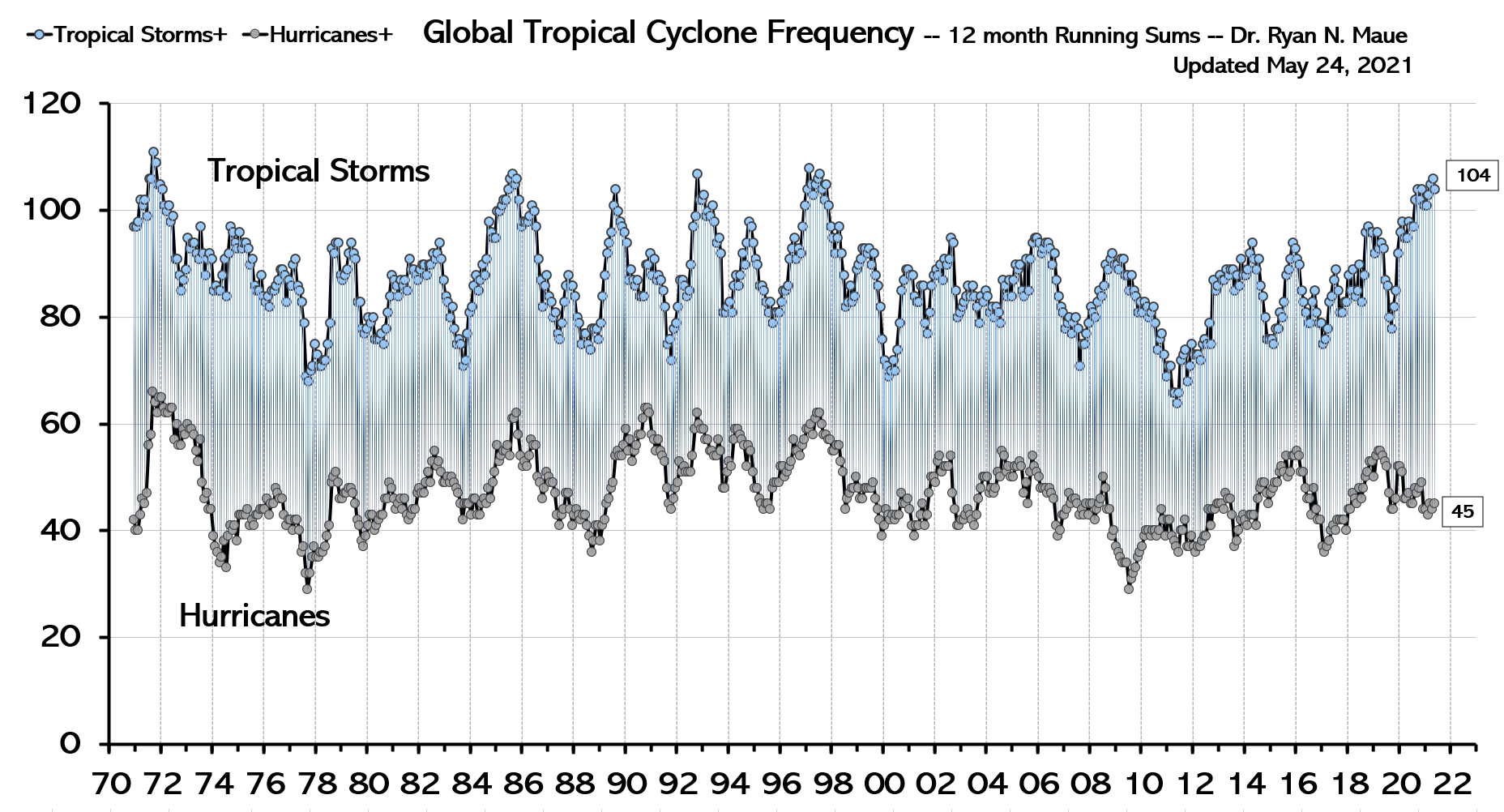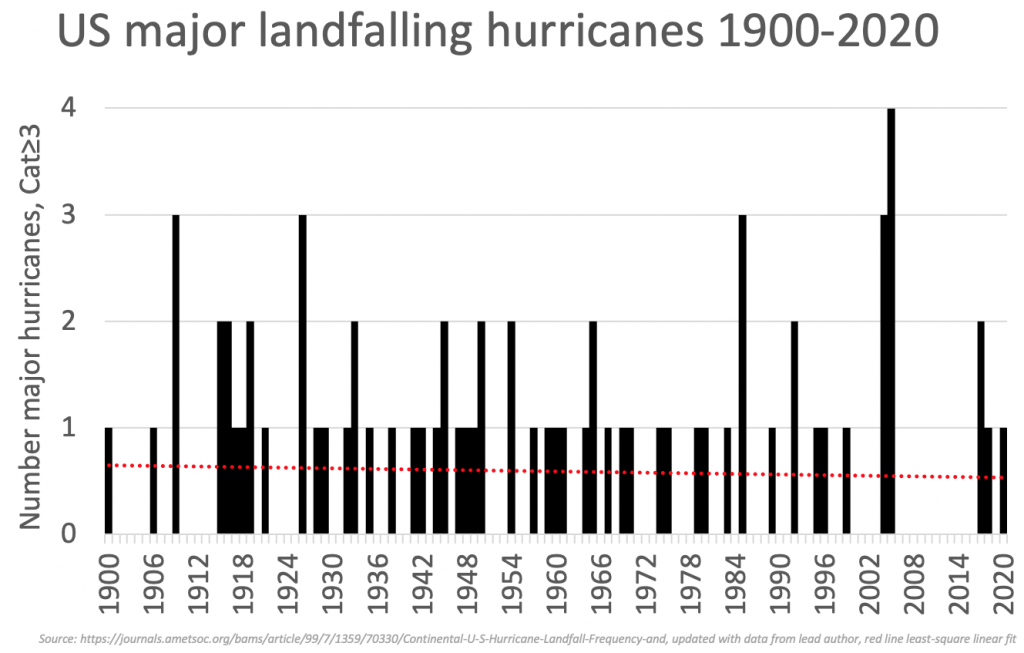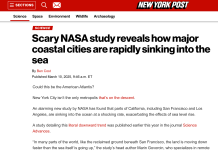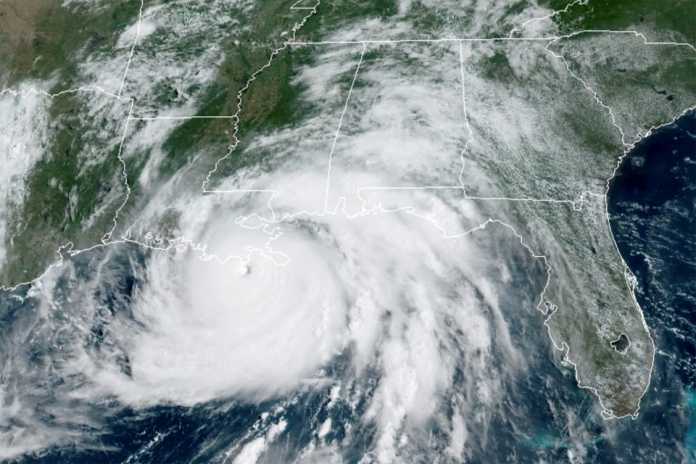A story in the Washington Post, titled “How climate change helped make Hurricane Ida one of Louisiana’s worst,” with Hurricane Ida as its news hook, asserts human caused climate change is driving more intense hurricanes. This is false. Data show tropical storms and hurricanes are neither more numerous nor more powerful than they have been historically. Not in Louisiana and not anywhere else.
By the time Hurricane Ida made landfall in Port Fourchon, La., on Sunday, it was the poster child for a climate change-driven disaster. The fast-growing, ferocious storm brought 150-mile-per-hour wind, torrential rain and several feet of storm surge to the most vulnerable part of the U.S. coast. It rivals the most powerful storm ever to strike the state.
“People there are going to get blasted,” said Kerry Emanuel, an atmospheric scientist at the Massachusetts Institute of Technology who studies the physics of hurricanes and their connection to the climate. “This is exactly the kind of thing we’re going to have to get used to as the planet warms.”
As powerful as Ida was when made landfall, the Post and Emanuel are wrong to link Ida or any particular hurricane to climate change.
Ida may rival the most powerful hurricanes ever to strike Louisiana, but that does not make it unique. Research shows since 1957 alone five hurricanes have made landfall in Louisiana with wind speeds exceeding 150 mph. The most powerful of those five hurricanes, 1969’s Category 5 Camille, had wind speeds exceeding 190 mph. Three of the five Category 4 or higher hurricanes Louisiana has experience in the past 70 years occurred during late 1950s and 1960s during a period when the earth was undergoing a period of modest cooling, and many scientists were warning of a coming ice age.
Data from the U.S. Environmental Protection Agency and the National Oceanic and Atmospheric Administration’s National Hurricane Center (NHC) show hurricanes have neither become more numerous or more powerful during the past half-century of modest warming.
EPA’s May 2021 report, titled “Climate Change Indicators: Tropical Cyclone Activity,” reported:
Since 1878, about six to seven hurricanes have formed in the North Atlantic every year. Roughly two per year make landfall in the United States. The total number of hurricanes (particularly after being adjusted for improvements in observation methods) and the number reaching the United States do not indicate a clear overall trend since 1878.
EPA’s conclusion that hurricanes have not become more numerous in recent years is unsurprising, because, U.N. Intergovernmental Panel on Climate Change (IPCC) 2018 interim report came to essentially the same conclusion. As illustrated in figure 1 below, IPCC data demonstrates no increasing trend in tropical cyclone or hurricane numbers.

NHC data indicate hurricane impacts on the United States are at an all-time low. The United States recently went more than a decade, 2005 through 2017, without experiencing a major hurricane measuring Category 3 or higher, making landfall—the longest such period in recorded history.
This can be seen in Figure 2 below showing the large gap with no major landfalling hurricanes (Category3 or greater) in the U.S. on the right-hand side.

Also from 2009 through 2017, the United States experienced the fewest number of hurricane strikes over any eight-year period, since records have been kept.
The U.N. Intergovernmental Panel on Climate Change’s 6th Assessment Report, released in early August, also finds limited evidence human caused climate change is causing more frequent or stronger hurricanes.
“There is low confidence in most reported long-term (multidecadal to centennial) trends in TC frequency- or intensity-based metrics,” writes the IPCC.
This is not surprising. As explained in Climate at a Glance: Hurricanes, warm ocean water is just one factor driving the formation and intensification of hurricanes. Wind shear inhibits strong storms from forming and rips apart storms that have already formed. Science indicates global warming is likely to cause more wind shear in places where hurricanes form and intensify. This is precisely what happened to Henri, in mid-August, with wind shear shredding its top reducing it from a minor hurricane to a tropical depression if a relatively short period of time.
While the human toll and economic costs of Hurricane Ida have yet to be totaled up, they are likely to be great. However, contrary to the Washington Post’s article, there is no evidence the recent modest warming of the earth contributed to Ida or any other recent hurricane’s formation or intensity. The facts show, recent hurricane numbers and wind speeds are well within historical norms. The Post should stop selling unwarranted climate alarmism on the back of real human misery.


















Why are tornados occurring more frequently in areas such as NJ in conjunction with such storms. I am not trying to contradict you, but really want to know what you think is causing what appears to be a new aspect to these storms where I live.
I find this article very informative. However, I would appreciate it if there were footnotes citing the source of a quotation precisely. For example, the reference to the IPCC’s Sixth Assessment Report quote refers to a document with nearly 4,000 pages. I would like to know where the quoted statement appears in the Report (if I use it I know I will be challenged – so this would be very helpful).